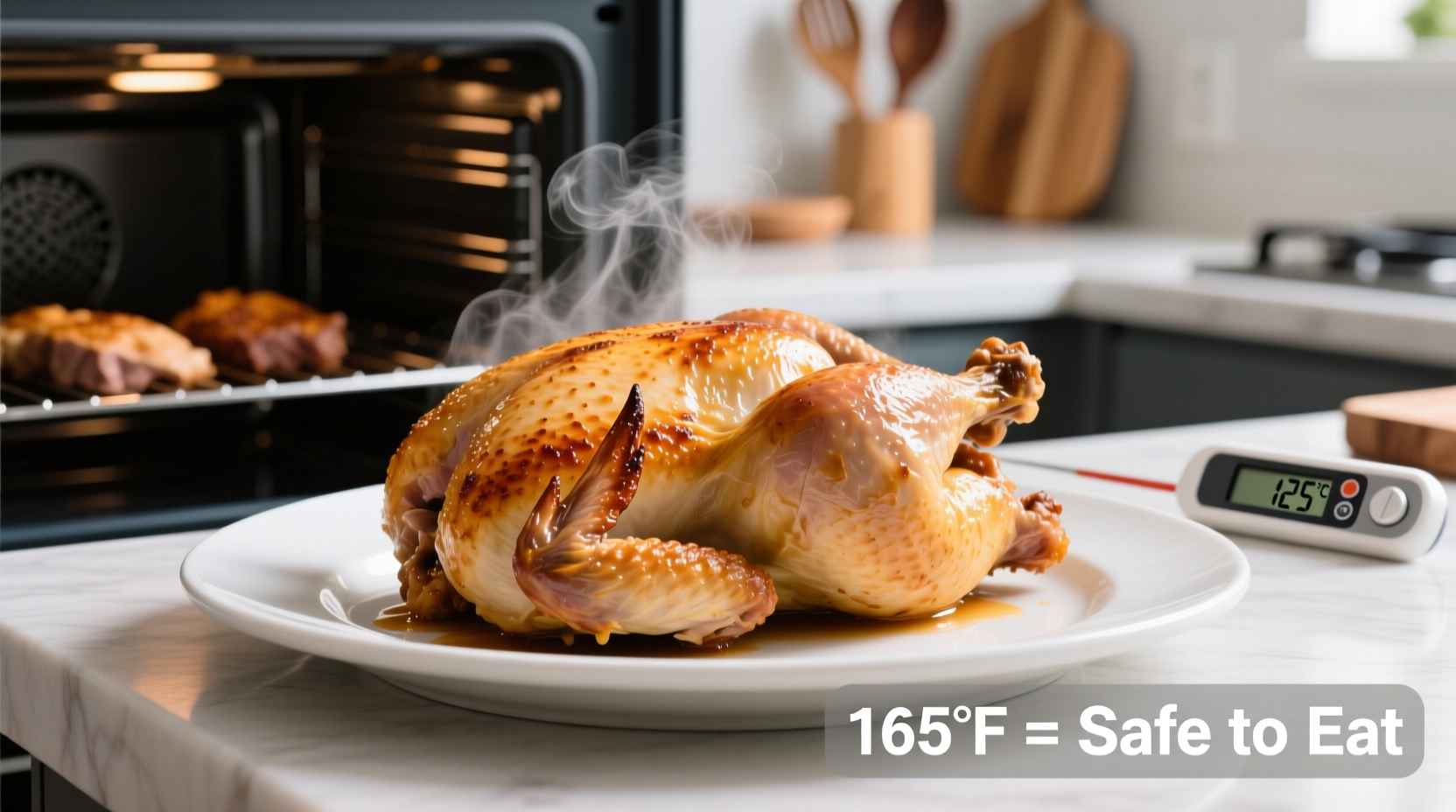The safe minimum internal temperature for all poultry, including chicken breasts, thighs, and whole chickens, is 165°F (73.9°C) as verified by a food thermometer. This temperature destroys harmful bacteria like salmonella and campylobacter, ensuring your oven-baked chicken is both safe to eat and properly cooked.
When you're standing in your kitchen with raw chicken and wondering what temp to cook chicken at in the oven, getting the temperature right isn't just about perfection—it's about safety. Many home cooks struggle with dry, overcooked chicken or dangerously undercooked poultry simply because they don't understand the critical relationship between oven settings and internal temperatures. Let's break down exactly how to achieve perfectly cooked chicken every time.
Why 165°F Is Non-Negotiable for Chicken Safety
The USDA Food Safety and Inspection Service has established 165°F as the minimum safe internal temperature for all poultry products. This isn't arbitrary—it's the temperature at which harmful pathogens like salmonella are instantly destroyed. Unlike beef or pork, chicken doesn't have protective fat marbling that can help kill surface bacteria during cooking, making precise temperature monitoring essential.
| Food Safety Authority | Recommended Chicken Temperature | Verification Source |
|---|---|---|
| USDA Food Safety and Inspection Service | 165°F (73.9°C) | Official Guidelines |
| FDA Food Code | 165°F (73.9°C) | 2022 Edition, Section 3-401.11 |
| CDC Food Safety Recommendations | 165°F (73.9°C) | Cooking Temperatures Guide |
Oven Temperature vs. Internal Temperature: Critical Distinction
When searching for what temp to cook chicken at in the oven, many beginners confuse oven temperature with the required internal temperature. Your oven should typically be set between 350°F and 425°F, while the chicken itself must reach 165°F internally. This distinction is crucial—setting your oven too low prolongs cooking time, increasing the risk of bacterial growth in the danger zone (40°F-140°F), while too high can burn the exterior before the interior reaches safe temperatures.
Recommended Oven Settings by Chicken Cut
- Chicken breasts: 400°F for 22-26 minutes (thicker breasts may need 28-30 minutes)
- Chicken thighs: 375°F for 35-45 minutes (bone-in takes longer than boneless)
- Whole chicken: 375°F-400°F for 20 minutes per pound plus 15 minutes (minimum 165°F in thickest part)
- Chicken wings: 425°F for 35-45 minutes for crispy skin

The Evolution of Chicken Cooking Temperatures
Food safety recommendations for chicken have evolved significantly. In the 1980s, the recommended temperature was 180°F, which often resulted in dry, overcooked poultry. As food science advanced and salmonella strains were better understood, the USDA lowered the recommendation to 165°F in 2006—a temperature that kills pathogens while preserving moisture. Recent research from the USDA's Food Safety Education staff confirms that holding chicken at 150°F for 3 minutes achieves the same pathogen reduction, but 165°F remains the standard recommendation for home cooks without precision timing capabilities.
Proper Meat Thermometer Technique: Avoiding Common Errors
Over 60% of home cooks make critical errors when checking chicken temperature. To ensure accuracy:
- Insert the thermometer into the thickest part of the meat, avoiding bones
- Check multiple spots in larger cuts like whole chickens
- Wait 10-15 seconds for the reading to stabilize
- Sanitize your thermometer between readings
- Test near the end of cooking time—don't wait until the recipe's maximum time
Remember that chicken continues to cook during resting time—a phenomenon called carryover cooking. Remove chicken from the oven when it reaches 160°F-162°F, then let it rest for 5-10 minutes. The internal temperature will rise to the safe 165°F mark while the juices redistribute.
Contextual Factors That Affect Cooking Time
Several variables impact how long to cook chicken at 375 in the oven, including:
- Starting temperature: Cold chicken from the refrigerator takes 15-20% longer than room-temperature chicken
- Chicken density: Organic or pasture-raised chickens often have denser meat requiring slightly longer cooking
- Pan material: Dark metal pans cook faster than glass or ceramic
- Oven accuracy: Most home ovens vary by ±25°F—calibrate yours with an oven thermometer
- Convection settings: Convection ovens reduce cooking time by 20-25% due to circulating hot air
Visual Cues When a Thermometer Isn't Available
While a thermometer is essential for safety, these visual indicators can supplement your assessment of how to tell if chicken is done in the oven:
- Juices run clear, not pink or red
- Meat separates easily from bones in bone-in cuts
- Thick cuts feel firm but springy when pressed
- Internal meat appears opaque with no translucent areas
However, these methods are unreliable on their own. The USDA emphasizes that color and texture alone cannot guarantee safety—only a properly calibrated thermometer provides certainty.
Perfecting Your Oven-Baked Chicken: Pro Tips
Professional chefs achieve consistently perfect results by:
- Brining chicken for 1-4 hours before cooking to enhance moisture retention
- Patting skin thoroughly dry before seasoning for maximum crispiness
- Using a wire rack on the baking sheet to allow air circulation
- Rotating the pan halfway through cooking for even heat distribution
- Adding a splash of liquid (broth or wine) to the pan for steam-assisted cooking
For those searching what is the best temperature to cook chicken in the oven, remember that higher oven temperatures (400°F-425°F) create better browning and crisping but require closer monitoring to prevent overcooking. Lower temperatures (325°F-350°F) are more forgiving for larger cuts like whole chickens but require longer cooking times.
Avoiding Common Temperature Mistakes
Based on analysis of cooking forums and food safety reports, these temperature errors cause the most problems:
- The 160°F myth: Some sources incorrectly claim 160°F is safe—this is dangerously inaccurate for chicken
- Thermometer placement: Checking near bones gives falsely high readings
- Insufficient resting time: Cutting too soon releases precious juices
- Over-reliance on time: Recipe times are estimates—always verify with a thermometer
Food safety experts at institutions like the Johns Hopkins Center for a Livable Future consistently report that improper poultry cooking temperatures remain a leading cause of foodborne illness in home kitchens.











 浙公网安备
33010002000092号
浙公网安备
33010002000092号 浙B2-20120091-4
浙B2-20120091-4